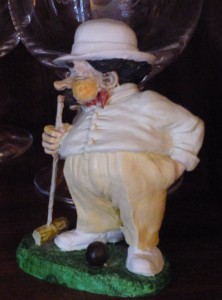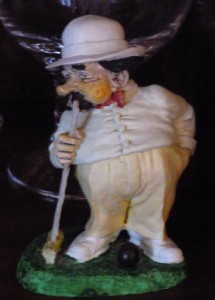Greetings and a bright spring welcome to a Blog with some personal views from the Square on the Hypotenuse at the late Perpendicular expression of Church that is St Pythagoras & All Angles. Lent should be a time of Selfie denial, but…

I know it’s easier to satirise than to sanctify, but, with our dear 470-year old Church of England having one of its mid-life crises, it’s hard to resist. In a weird game of chess, knights and bishops have been issuing green reports willy-nilly that tell us how we can be better pawns – sorry, disciples – if we do Church their way.
In the spirit of such reports, I have been developing a Lent Discipleship Course with our sister church, Santa Croce in Extremis, based on the game of Croquet, beloved of Edwardian Vicarage lawns. The Genesis of Croquet is hidden in the long grass of time, but when I did Croquet it was played by earnest young men and intelligent little old ladies; a microcosm of the CofE in its heyday.

Croquet is like a cross between Snooker and Quidditch, played on grass, and is a parable of the religious life with many hoops to be run, hopefully with a partner ball, before you peg out. Each of the 6 hoops offers the disciple 2 spiritual lessons.
1. Liturgical colours – save for purple (Advent/Lent), the balls cover the whole set of liturgical colours; blue (Our Lady) and black (All Souls) play red (Martyrs) and yellow (golden Christmas & Easter), while in a second game white (Our Lord) and pink (Gaudete/Laetare) play brown (Lenten Array) and green (Trinity/Ordinary). I can sing a rainbow.
2. Integrities – with primary and secondary colours, 2 games can be played on the same lawn; like 2 Integrities in the same Church.
3. Roquet – when one ball strikes another; useful for puns like “Roquet of Ages, cleft for me” and “What cheese do croquet players like? Roquefort”.
4. Croquet – place your ball against the roqueted ball and strike it so both move; you will achieve more by playing constructively to build a break using balls of many colours, rather than banishing balls to the long grass, however tempting it may seem.
5. Temptation – even though the CofE has written the Devil out of its Baptism promises, the Dark Lord will still try and tempt you by “laying a tice”; playing his ball a tempting distance from yours to entice you to shoot and miss and hinder your progress around the course.
6. Fellowship – to win at Croquet, you have to help your partner ball to run all the hoops as well as you; isn’t the Christian life a bit like a game of Croquet?
At this half-way point the course offers a variety of activities, depending on which option you are playing.
a. Alpha – receive your teeth-whitening and Songs of Praise smile.
b. Emmaus – special afternoon tea with Jesus before returning to Jerusalem.
c. Pilgrim – historical visit to Stonehenge to stand where Merlin taught Dumbledore to play Wizards’ Croquet.
d. Scientist – tax-free visit to the Large Hadron Croquet facility at CERN where relativistic roquets result in non-Newtonian behaviour of the balls. Find a Higgs boson and celebrate Mass.
e. Social media – visit the Land of Pure Tea-lights that is home to the Beaker Folk of Husborne Crawley for a retweet led by Archdruid Eileen.

7 (known as 1 back). Stewardship – you like playing Croquet, so consider joining the Club as a regular member; ask the Treasurer about subscription options.
8 (2 back). Disappointment (the bit some other courses miss out) – no one wins every game and very few get through all the hoops of life without setbacks; when you’re experiencing the Long Grass of the Soul or feeling short-changed by God, seek help, try changing your grip or your swing, or even change your Club, but above all persevere.
9 (3 back). Meditation – while sitting out (when the opponents are in play) you may crochet a lacy cotta for a server.
10 (4 back). Theology – from here one player can, with considerable intellectual and physical skill, peel their partner ball though the last 3 hoops while running their own hoops in a feat of joined-up play known as a Triple Peel.
11 (Penult). Inclusive/Welcoming – with the help of bisques (free turns, not soup) all ages and genders can play Croquet on a level cathedral green; is your Church – sorry, Club – a community which welcomes new players, explains how to play and offers coaching if wanted?
12 (Rover). Vespers – the end is nigh; get the thurible going so you can incense any wasps that try to spoil your enjoyment of felicity at the heavenly bun-fight.
Peg-out – and go to the club-house banquet for tea and cucumber sandwiches (Evangelicals) or prosecco and strawberries (Anglo-Catholics). Join the Lord of the Dance and do the Roquet-Croquet.

Into the growing Oxford Movement English Dictionary, I can add:-
Aga Father – the Vicar’s divine cookery course.
Chair Practice – replaces Choir Practice when a Church is re-ordered.
Choroclasm – destruction of robed choirs in the late 20th century to be replaced by worship groups.
Petanque – a French Expression of Croquet.
Subjunctivitis – a pedantic need to use the correct mood of the verb, if there be a conditional clause.
Taize – a French Impression of Church.
West Gallery Band – historical worship group.
Wolf Whistles – Tudor Organ Music.
On BBC4 Dr Janina Ramirez has been exploring Britain’s monastic history from the asceticism of the Celts to the successful organisations which flourished prior to the dissolution of the monasteries in the 16th century. Her first revelation was that the Celtic Church was not led by grass-roots, tree-hugging eco-activists, but by sons of wealthy clan chieftains, given land and money to found monasteries as powerhouses of prayer. Effective evangelism started with converting the king, or his wife, and then faith would trickle down through the court and out to the folk.
In a spin-off programme, PyTV presents “I’m a Celibate, get me out of here.” A dozen ascetics from all faiths and nuns compete in tasks like Baking honey & locust cakes, Strictly liturgical dancing (remember the diaphanous 1970s), the Chant, and the Great Cistercian Sewing Habit, overseen by a black-robed Scottish bishop with a Raven-headed crozier; let the challenge … begin.
The Pythagoras Institute for Indisciplinary Studies is disappointed that no fragments of “Fulge Jesu Fulge” have turned up in the Oxyrhynchus papyri or indeed in the Ipplepen Roman cemetery.
However, for Latin Lovers, our Codex Dinhamensis contains a fragment from Carmina pueri puellaeque, Children’s Songs, found in De Revolutionibus Wheelsondibus by Nickelodeon Copernicus published in 1543 just before tea-time. In particular
“Caput umeris genua et digitos genua et digitos,
oculos et aures et os atque nares”
makes me wonder whether medieval choirboys warmed up with a few verses of “God be in my head, shoulders, knees and toes” before practising
“Deus in capite et in intellectu meo, Deus in oculis meis et in aspicientibus …”, familiar to us through the music of Walford Davies and John Rutter.
Maths Angle – the Church of England is now like a quadratic equation with 2 valid solutions, see Hoop 2 above. E.g. x^2-9x+8=0, (x-1)(x-8)=0, so x=1, for those who cannot accept women as priests or bishops, and x=8, for those who have accepted women as priests and bishops. Writing a cubic equation that includes gay bishops is left as an exercise for the reader.
Punctuation Point – advert seen in the Church Times.
The Haberdashers’ Aske’s Boys’ School – Nurturing Excellence – in apostrophes, presumably!
What did the dough say to the baker? It’s nice to be kneaded.
No hedgehogs or flamingos were harmed in the making of this blog.
Richard Barnes.